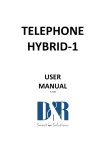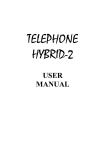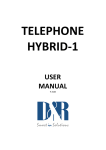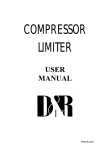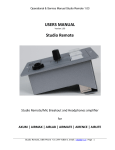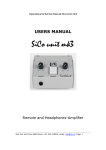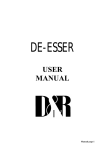Download USER MANUAL - Audmax Broadcast
Transcript
TELEPHONE HYBRID-2 USER MANUAL Dear Customer, Thank you for choosing the Telephone Hybrid-2. This time you are not faced with a huge manual because it is simply not necessary because of the natural recognition of all functions on the user interface. All functions are self-explanatory and you will certainly appreciate the ergonomics of this design. We are confident that you will be using the Telephone Hybrid for many years to come, and wish you a lot of success with your operation. With kind regards, Duco de Rijk PRESIDENT D&R ELECTRONICA WEESP B.V. Rijnkade 15B 1382 GS WEESP-HOLLAND The Netherlands Phone: 0294-418 014 Fax: 0294-416 987 Website: http://www.d-r.nl E-mail: [email protected] Manual page 2 D&R’s newest Telephone Hybrid-2 is the active version of the well known passive one, successfully sold over the last 5 years. Its concept originates from many demands for a more sophisticated hybrid with more features. The Telephone Hybrid-2 is an analogue unit with digital control and features like ducking making intelligibility a lot better in broadcast.. What is a telephone hybrid? Telephone hybrids provide the interface between professional audio equipment and the public telephone network. They provide protection for your equipment and the public telephone lines, allowing for varying line signals and line conditions. Automatically canceling out the unwanted signal they also facilitate two-way communication down a single telephone line. Each hybrid has a telephone line connection, a handset connection and separate connectors for audio input and output from a broadcast mixer, or other professional audio source. A large proportion of D&R hybrids are used in radio and television broadcasting applications allowing external callers to be connected to the studio mixing console. Most of the other units are supplied to communication operations allowing extremely effective conversion between 4-wire audio circuits and standard telephone lines. Front panel lay-out CONNECT BUTTON: (RING) LC: HC: Ducking RECEIVE: SEND: Line connect switch to connect and disconnect calls from the telephone line. It can be remotely driven by connecting a switch to the GPIO sub D connector. Variable Low Cut filter to filter out unwanted low frequency noise. Variable High Cut filter to filter out unwanted high frequency noise. Indicates when caller’s signal is reduced. Level control for incoming signal from caller. Level control for outgoing signal to caller. . Manual page 3 Back panel lay-out Power Power Cord LINE: PHONE: C-BALANCE: R-BALANCE GPI AUDIO + GPIO RECEIVE SEND mains power switch. The unit is powered by a removable IEC type power cord. An internal switch is provided for 115/230V selection. RJ-12 connector to connect with the public telephone network. RJ-12 connector to connect with a handset. 8 pole mini-dip switch to select the optimum side tone attenuation. Internal potentiometer to adjust for optimum side tone attenuation. Jack connector for remote control. (1:1 for D&R’s Scorpius console) A combination of audio in/outputs and logic for D&R’s Lyra console. Male XLR to be connected to input of the mixer. Female XLR input to be connected to Mix Minus/Clean feed (N-1)output of the mixer. SYSTEM DESCRIPTION. A large ring button enables you to pick up the line from the unit itself or from your mixer when connected via its GPIO to the telephone Hybrid. When a call comes in it lights up green in the rhythm of the ring. When the line is picked up by pushing the button it turns into red. When it starts blinking red the line connection is lost. Both levels of receive and send can be adjusted to suit your requirements. Incoming signals can be tailored by the variable high and low cut signal while talking to people calling the station. A ducking system reduces the incoming signal while talking to people calling the station to provide for an improved intelligibility. HIGH LIGHTS. • • • • • • • • Active balanced interfacing. Variable high and low cut filters. Industry standard connectors Superb audio separation. Externally adjustable R and C balance. Remotely controllable. GPIO interfacing with mixing consoles. Auto Ducking. Manual page 4 SETTING UP PROCEDURE Connect the two wires of the telephone line’s wall unit to the RJ-11 connector labeled LINE and connect the telephone appliance itself to the Hybrid’s RJ-11 connector labeled PHONE. Note that to originate calls, a local phone must be connected to the system. Now the hybrid is interfaced (fully balanced) between your telephone appliance and its connection to the outside world. The hybrid can now split the send and return signals. Now connect the hybrid’s balanced audio input (SEND on XLR male) to a (preferable) balanced mixer output of around +4dBu. This output has to be the mix of all signals except the signal coming from the hybrid itself to avoid feedback. An Aux. output will do or in broadcast mixers a clean-feed is the best. The balanced RECEIVE output of the Hybrid has to be connected to a line input of the mixing console. Note that this signal is NOT to be send to the output where the Hybrid’s input is connected to. So in case of use of an Aux send this local channel Aux send needs to be turned off. In case of use of a clean-feed buss, this input channel needs to be disconnected from the clean-feed buss. Turn the LC control fully counter clockwise and the HC control fully clockwise. Position RECEIVE and SEND controls in their mid position. If a local phone is connected, originate a call to a remote side. If no local phone is present, someone at a remote site must call you. When a call comes in the large ring BUTTON on the left side of the unit lights up green in the rhythm of the ring. When the line is picked up by pushing the button it turns into red. When it starts blinking red the line connection is lost. If you are at the originating side pres the CONNECT button to connect the Telephone Hybrid-2 to the phone line after the call has been established. The phone will be disconnected now. The caller will now hear the signal send to the Hybrid and the output of the Hybrid will present the callers signal only with the send signal heavily attenuated. To achieve the optimum attenuation you need to adjust the C and R balance first. This is how it is performed: 1. Check if the telephone connection is established and all connections to the mixing console are correctly wired. 2. Now activate a CUE/PFL/SOLO button of the mixing console channel where the return signal of the Hybrid is connected to. You will faintly hear the send signal coming out of the mixing console. 3. Adjust the R-Balance for minimum feed through of the mixers send signal. 4. Listen now which mini-dip switch gives a further reduction of the return signal. 5. Maybe it is good to re-adjust the R-balance after having selected another dip-switch. 6. Repeat steps 3 and 4 until no further improvement are achieved. Manual page 5 DUCKING The Hybrid has an automatic gain adjustment of the incoming signal from the caller when the presenter speaks. This feature both improves the side tone reduction and gives the presenter a level advantage over the caller when he interrupts the caller. When both parties are speaking the caller’s signal is reduced then. INPUTS / OUTPUTS SEND (to caller) XLR FEMALE Pin 1 Pin 2 Pin 3 TYPE Screen Phase Non-phase CONNECTION Audio ground Audio + (input) Audio – (input) TYPE Screen Phase Non-phase CONNECTION Audio ground Audio + (output) Audio – (output) FUNCTION Receive (from caller) Receive (from caller) Receive (from caller) Send (to caller) Send (to caller) Send (to caller) Logic ground GPI GPO CONNECTION Audio + (output) Audio - (output) Audio ground Audio + (input) Audio – (input) Audio ground 47 Ohm to ground + 5volt TTL input Open collector to ground RECEIVE (from caller) XLR MALE Pin 1 Pin 2 Pin 3 SUB D-9 AUDIO + GPIO GPIO / SEND / RECEIVE Pin 1 Pin 6 Pin 2 Pin 7 Pin 3 Pin 8 Pin 4 Pin 9 Pin 5 Manual page 6 GPI GPI Tip Ring Sleeve FUNCTION Pull down Pull up No CONNECTION 47 ohm to ground +5 volt via 10kohm Not connected FUNCTION n.c. A (telephone line) B (telephone line) n.c. CONNECTION FUNCTION n.c. A (telephone line) B (telephone line) n.c. CONNECTION PHONE PHONE RJ12 Pin 1 Pin 2 Pin 3 Pin 4 In/out In/out LINE LINE RJ12 Pin 1 Pin 2 Pin 3 Pin 4 In/out In/out SPECIFICATIONS Audio Inputs SEND Impedance Common mode rejection Maximum input level Nominal input level Frequency response Connectors Gain range receive control 10k Ohm, electronically balanced >40dB +26dBu +4 dBu 20Hz – 15kHz (-3dB variable via HC and LC filters) XLR type 3 pin female 40dB Manual page 7 RECEIVE Impedance Common mode rejection Maximum output level Nominal output level Bandwidth to telephone line Telephone line impedance Telephone line impedance range Connectors Gain range send control GENERAL Distortion Power supply Power consumption Dimensions Weight < 50 Ohm, electronically balanced >40dB +26dBu +4 dBu 250Hz – 4kHz, -3dB ref 1 kHz Nominally 600 ohm 300 ohm to 1500 ohm XLR type 3 pin male +6dB to –20dB Less than 0.1% (0dBu out) 115v / 230 v AC / 50/60Hz (factory set, NOT do this yourself) 10VA Maximum 1 HE front panel: 482x44mm Frame: 430x41x175mm (width x height x depth) 2.2 kg net excl packing Manual page 8 INSTALLATION Manual page 9 DECLARATION OF CONFORMITY Manufacturers Name: D&R Electronica Weesp b.v. Manufacturers Address: Rijnkade 15B, 1382 GS Weesp, The Netherlands declares that the product TELEPHONE HYBRID-2 Which refers to this declaration, is in accordance with the following standards or standardized documents: EN 50081-1 EN 50082-1 EN 60065 EN 55020 EN 55013 A 12 EN 55022 EN 61000-3-2 EN 61000-3-3 Supplementary Information: The products herewith complies with the requirements of the EMC Directive 89/336/EWG and 73/23/EWG as amended by the CE Marking Directive 93/68/EEC (1993). Duco de Rijk president August 2003 D&R Electronica Weesp b.v. Rijnkade 15 B 1382 GS WEESP The Netherlands Manual page 10 PRODUCT SAFETY This product is manufactured with the highest standards and is double checked in our quality control department for reliability in the "HIGH VOLTAGE" section. CAUTION Never remove any panels, or open this equipment. No user serviceable parts inside. Equipment power supply must be grounded at all times. Only use this product as described, in user manual or brochure. Do not operate this equipment in high humidity or expose it to water or other liquids. Check the AC power supply cable to assure secure contact. Have your equipment checked yearly by a qualified dealer service center. Hazardous electrical shock can be avoided by carefully following the above rules. PLEASE READ THE FOLLOWING INFORMATION Especially in sound equipment on stage the following information is essential to know. An electrical shock is caused by voltage and current, actually it is the current that causes the shock. In practice the higher the voltage the higher the current will be and the higher the shock. But there is another thing to consider and it is resistance. When the resistance in Ohms is high between two poles, the current will be low and vice versa. All three of these; voltage, current. and resistance are important in determining the effect of an electrical shock. However, the severity of a shock primarily determined by the amount of current flowing through a person. A person can feel a shock because the muscles in a body respond to electrical current and because the heart is a muscle it can affect, when the current is high enough. Current can also be fatal when it causes the chest muscles to contract and stop breathing. At what potential is current dangerous. Well the first feeling of current is a tingle at 0.001 Amp of current. The current between 0.1 Amp and 0.2 Amp is fatal. Imagine that your home fuses of 20 Amp can handle 200 times more current than is necessary to kill. How does resistance affect the shock a person feels. A typical resistance between one hand to the other in "dry" condition could well over 100,000 Ohm. If you are playing on stage your body is perspiring extensively and your body resistance is lowered by more than 50%. This is a situation in which current can easily flow. Manual page 11 Current will flow when there is a difference in ground potential between equipment on stage and in the P.A. system. Please do check if there is any potential between the housing of the mikes and the guitar synth amps, which will be linked by your body on stage. Imagine, a guitar in your hand and your lips close to the mike! A ground potential difference of above 10 volts is not unusual, in improperly wired buildings it can possibly be as high as 240 volts. Although removing the ground wire sometimes cures a system hum, it will create a very hazardous situation for the performing musician. Always earth all your equipment by the grounding pin in your mains plug. Hum loops should be only cured by proper wiring and isolation input/output transformers. Replace fuses always with the same type and rating after the equipment has been turned off and unplugged. If the fuse blows again you have an equipment failure, do not use it again and return it to your dealer for repair. And last but not least be careful not to touch a person being shocked as you, yourself could also be shocked. Once removed from the shock, have someone send for medical help immediately Always keep the above mentioned information in mind when using electrically powered equipment. Manual page 12 . TELEPHONE HYBRID-2 SERVICE MANUAL Manual page 13













